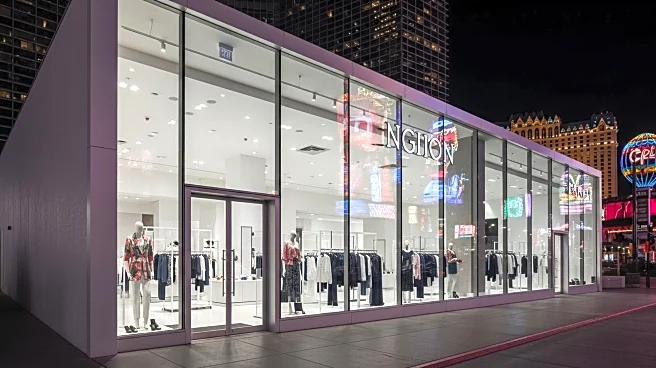What's Happening?
Levi Strauss & Co. has reported a 7% increase in net revenues for the third quarter of 2025, reaching $1.5 billion. President and CEO Michelle Gass announced the potential to double the company's U.S.
store count, although no specific timeline was provided. Currently, Levi's operates 458 locations across the United States. The company's direct-to-consumer (DTC) net revenues grew by 11% compared to the previous year, with e-commerce sales increasing by 18%. DTC sales accounted for 46% of total net revenues for the quarter. Levi's aims to leverage its denim leadership to expand its market reach and enhance profitability across both DTC and wholesale channels. Additionally, the company sees growth opportunities in Asia, where net revenues increased by 12% year-over-year.
Why It's Important?
The expansion of Levi's store footprint in the U.S. signifies a strategic move to strengthen its market presence and consumer engagement. By focusing on direct-to-consumer sales, Levi's is positioning itself to capture a larger share of the retail market, which is increasingly driven by consumer preferences for direct engagement with brands. The growth in e-commerce and international markets, particularly in Asia, highlights Levi's ability to adapt to global retail trends and capitalize on emerging markets. This expansion could lead to increased competition in the retail sector, potentially impacting other apparel brands and retailers. The company's focus on innovation and product diversification may also set new standards in the denim and lifestyle segments.
What's Next?
Levi's plans to continue its expansion with additional store openings in Boston, Houston, and Northern California, increasing its Beyond Yoga banner store count to 14. The company is committed to enhancing its operational efficiency and supply chain improvements to support this growth. As Levi's pursues its DTC-first strategy, it may face challenges related to maintaining profitability and managing increased operational costs. Stakeholders, including investors and competitors, will likely monitor Levi's progress in expanding its U.S. footprint and its ability to sustain growth in international markets.
Beyond the Headlines
Levi's expansion strategy reflects broader trends in the retail industry, where brands are increasingly focusing on direct consumer engagement and international market growth. The company's emphasis on performance culture and operational excellence may influence industry standards, encouraging other retailers to adopt similar strategies. Additionally, Levi's growth in Asia underscores the importance of emerging markets in the global retail landscape, potentially prompting other U.S. brands to explore opportunities in these regions.













